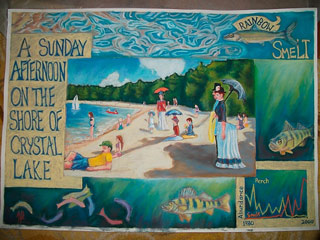Artists, scientists collaborate on exhibit focusing on ecological change
In the popular imagination, the thought processes of artists and scientists could hardly be more distinct. And yet a year-long collaboration of lake scientists and artists from northern Wisconsin has engaged both sides of the “divide” in understanding and communicating the changing ecology in one of the world’s densest group of lakes — in the northern highlands of Wisconsin.

‘A Sunday Afternoon on the Shore,’ pastel, Terry Daulton, is one of several works on display in the exhibition, ‘Drawing Water: Artists and Scientists Explore Northern Lakes.’ View a slide show of other works in the exhibition.
On Tuesday, April 12, the collaboration will unveil “Drawing Water: Artists and Scientists Explore Northern Lakes” at the Wisconsin Association of Lakes conference in Green Bay. The exhibit contains works by five visual artists and one poet, each accompanied by a concise explanation of the science behind the art.
Art is a method of communication that scientists seldom use, said Emily Stanley, a professor of zoology at University of Wisconsin–Madison and principal investigator of the North Temperate Lakes Long Term Ecological Research program, funded by the National Science Foundation. The program is housed at the Trout Lake, Wis. Research Station, near Boulder Junction, Wis.
“Some people have a visceral reaction against science, but we’re hoping that art can draw people in to the facts at an emotional level,” Stanley says.
Stanley explains that the project is a natural outgrowth of Trout Lake Station’s historic mission — to document and understand how the lake country has changed since Trout Lake Research Station was established by two UW–Madison scientists in 1924.
At that time, loggers had left a forest of tree stumps, and erosion, tree planting, highways and the first summer cottages were bringing another wave of change to the north woods.
“Art can move people in a way other media, other kinds of information cannot,” says Terry Daulton, a painter from Mercer, who helped organize the June 2010, meeting of lake researchers and artists that started the collaboration.
Discussion at the meeting focused on how development, changes in plants, animals and climate have affected the lakes and the landscape. Through visits to Trout Lake and nearby water bodies, the artists became acquainted with the different ways that vegetation, geology and water can give lakes distinct differences in water quality and biology, despite being located within a few miles of each other.
“From the ancient cave artists to pop culture, artists have been thinking about the natural world and change since the beginning,” says Daulton. “Now we’ve had the chance to talk with all these great scientists, and then respond as poets and visual artists to what we’ve learned. All of us live in the north woods, and all of us love nature, but now we’ve had a chance to see it from a totally different perspective.”
“The best teaching is revelation, an epiphany people come to on their own,” says John Bates, a poet from Manitowish. “How do we make it so people can have these ‘Aha!’ moments?”
The exhibit will include:
- “Of Bogs and Benthos,” an embroidery by Bonnie Peterson of Houghton, Mich., which uses the traditional techniques of embroidery and stitching to teach basic concepts of freshwater science by incorporating scientific graphs, maps and historic documents.
- “Vanishing Act,” a watercolor by Mindy Schnell of Boulder Junction, Wis., shows the expansion of invasive rainbow smelt at the expense of a school of fading, native walleye.
“Scientists often work in a cocoon, and while we take our work seriously, we are always looking to find new ways to communicate,” says Stanley. Referring to lakes near Boulder Junction, she asks, “When people visit Sparkling Lake, do they understand how it was changed by logging, and then by the introduction of an invasive crayfish? When people camp and swim at Crystal Lake, do they understand why its water is so clear — and how that clarity can be threatened by ecological decline? These are the kind of issues that we hope these northwoods artists can communicate.”
“Drawing Water” will be displayed at several northern locations, including the Lac du Flambeau Woodland Indian Art Center, Presque Isle library, Crystal Lake Visitor Center, North Lakeland Discovery Center, Nicolet Community College, and Trees for Tomorrow.
Do you notice all these things, too?
How the sun feels on your face
how the clouds flow in different directions from the wind on the lake
how the stones in the clear water pulse in the play of light
how the song sparrow sings again and again from the alders
how the smell of the sand the sun the water the lilies is so sweet?
Life comes into focus
and you find the philosopher
that has been waiting so long in your head.
– John Bates
Tags: arts, biosciences, limnology, water




